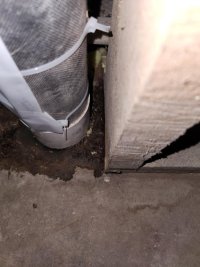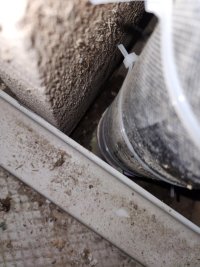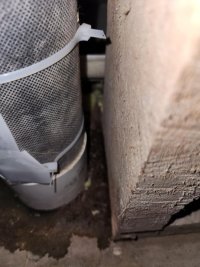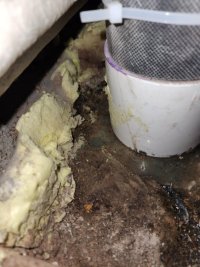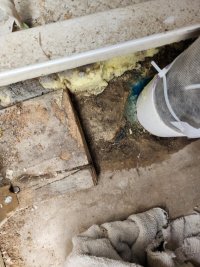lhgrappler
New Member
TLDR: Plumbers messed up, main stack has a poorly placed coupling half way into the cement floor that is leaking. We need to fix it asap, BUT I have no idea how to break away the cement in such a small area next to a mortared shower pan.
We have had so many issues with these plumbers. We are have drywall go up on the completely gutted and remodeled house Monday. Yesterday I saw some suspicious water on the floor in the basement where the main stack goes into the concrete. I decided to send dyed water down through waste plumbing to see if it was leaking, or just water coming up from underneath. Sure enough, we saw the dyed water coming out. There was no reason for them to even be messing with the stack that low, my husband thinks maybe they put to much strain on it and broke it. They definitely did not chip away enough concrete to properly repair it that low.
This was absolutely heartbreaking, we've been living in a camper for 2 years during this reno and I can NOT delay drywall again, I will end up in the loony bin.
The plumber is not answering our text or calls (we texted him pictures of the dye test that showed the leak)
I want to just do it so its done right. BUT there is no space what so ever right there. I would GREATLY appreciate and ideas on how to do this without ripping out the mortared shower pan right nest to it. If I have to cut away some of the stud next to it, that might be ok, but there is a supply line going through it, so I can't just remove the whole thing.
Excuse the mess in the pictures.
Yellow stuff is foam used for leveling the floor, white thing is mortared in place shower pan, the pipe is wrapped in mass loaded vinyl.
We have had so many issues with these plumbers. We are have drywall go up on the completely gutted and remodeled house Monday. Yesterday I saw some suspicious water on the floor in the basement where the main stack goes into the concrete. I decided to send dyed water down through waste plumbing to see if it was leaking, or just water coming up from underneath. Sure enough, we saw the dyed water coming out. There was no reason for them to even be messing with the stack that low, my husband thinks maybe they put to much strain on it and broke it. They definitely did not chip away enough concrete to properly repair it that low.
This was absolutely heartbreaking, we've been living in a camper for 2 years during this reno and I can NOT delay drywall again, I will end up in the loony bin.
The plumber is not answering our text or calls (we texted him pictures of the dye test that showed the leak)
I want to just do it so its done right. BUT there is no space what so ever right there. I would GREATLY appreciate and ideas on how to do this without ripping out the mortared shower pan right nest to it. If I have to cut away some of the stud next to it, that might be ok, but there is a supply line going through it, so I can't just remove the whole thing.
Excuse the mess in the pictures.
Yellow stuff is foam used for leveling the floor, white thing is mortared in place shower pan, the pipe is wrapped in mass loaded vinyl.

